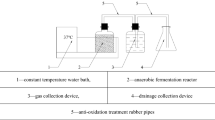Abstract
A mathematical model was formulated to simulate the long-term performance of an anaerobic bioreactor designed to digest Korean food wastes. The system variables of various decomposition steps were built into the model, which predicts the temporal characters of solid waste, and volatile fatty acid (VFA) in the reactor, and gas production in response to various input loadings and temperatures. The predicted values of VFA and gas production were found to be in good agreement with experimental observations in batch and repeated-input systems. Finally, long-term reactor performance was simulated with respect to the seasonal temperature changes from 5°C in winter to 25°C in summer at different food waste input loadings. The simulation results provided us with information concerning the success or failure of a process during long-term operation.
Similar content being viewed by others
References
Ministry of Environment website; http://www.food-waste.or.kr.
Cho, J. K., S. C. Park, and H. N. Chang (1995) Biochemical methane potential and solid state anaerobic digestion of Korean food wastes.Biores. Technol. 52: 245–253.
Park, J. B., Y. S. Kim, S. S. Choi, and S. H. Han (2000) The optimum condition for the co-digestion of food waste and sewage sludge.J. Kor. Org. Waste Recycling Council, http://www.kowrec.org/journal/8-2/journal8_2_6.htm.
Kim, S. W. and S. C. Park (2000) Production of biogas and digestion of food waste using methane fermentation.Lett. Ind. Microbiol. 13: 30–34.
Andrews, J. F. (1969) A dynamic model of anaerobic digestion process.J. Saint. Eng. Div. ASCE 95-SA1: 95–110.
Mosey, F. E. (1983) Mathematical modeling of anarobic digestion process: regulatory mechanisms for the formation of short-chain volatile acids from glucose.Wat. Sci. Technol. 15: 209–217.
Dalla, T. A. and G. Stephanopoulos (1986) Mixed culture model of anaerobic digestion: application to the evaluation of startup procedures.Biotechnol. Bioeng. 28: 1106–1118.
Mata-Alvares, J. (1987) A dynamic simulation of two-phase anaerobic digestion system for solid wastes.Biotechnol. Bioeng. 30: 844–851.
Shimizu, T., K. Kudo, and Y. Nasu (1993) Anaerobic waste-activated sludge digestion: A bioconversion mechanism and kinetic model.Biotechnol. Bioeng. 41: 1082–1091.
Kalyuzhnyi, S. V. and M. A. Davlyatshina (1997) Batch anaerobic digestion of glucose and its mathematical modeling: I. Kinetic investigations.Biores. Technol. 59: 73–80.
Kalyuzhnyi, S. V. (1997) Batch anaerobic digestion of glucose and its mathematical modeling: II. Description, verification and application of model.Biores. Technol. 59: 249–258.
APHA (1992) Standard methods for examination of water and wastewater, 18th ed., American Public Health Association, Washington, DC, USA.
Gujer, W. and A. J. B. Zehnder (1983) Conversion processes in anaerobic digestion.Wat. Sci. Technol. 15: 127–167.
Ahring, B. K. and P. Westerman (1988) Product inhibition of butyrate metabolism by acetate and hydrogen in a thermophilic coculture.Appl. Environ. Microbiol. 54: 2393–2397.
Choi, D. W. (1998)A Study on the Anaerobic Digestion of Korean Food Waste and Its Mathematical Modeling, MS Thesis KAIST, Korea.
Bailey, J. E. and D. F. Ollis (1986)Biochemical Engineering Fundamentals. 2nd ed., McGraw-Hill, New York, USA.
Denac, M., A. Miguel, and I. J. Dunn (1988) Modeling dynamic experiments on the anaerobic degradation of molasses wastewater.Biotechnol. Bioeng. 31: 1–10.
Tom D. Reynolds, and Paul A. Richards (1996)Unit Operations and Process in Environmental Engineering, 2nd ed. International Thomson Publishing Asia, Singapore and USA.
Lin, C. Y., T. Noike, K. Sato, and J. Matsumoto (1987) Temperature charateristics of the methanogenesis process in anaerobic digestion.Wat. Sci. Technol. 19: 299–310.
The Korean Nutrition Society (1998)Food Values of Portions Commonly Used. The Korean Nutrition Information Center, Seoul, Korea.
Author information
Authors and Affiliations
Corresponding author
Rights and permissions
About this article
Cite this article
Choi, D.W., Lee, W.G., Lim, S.J. et al. Simulation on long-term operation of an anaerobic bioreactor for Korean food wastes. Biotechnol. Bioprocess Eng. 8, 23–31 (2003). https://doi.org/10.1007/BF02932894
Received:
Accepted:
Issue Date:
DOI: https://doi.org/10.1007/BF02932894




